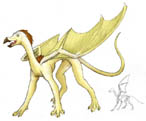
About Tryne
(Physical and Biological)
Maps/Cities
Fauna A-K
Fauna L-Z
Flora A-M
Flora N-Z
Pets
Diseases
About Tryne
(Cultural)
History
The Elementals
Calender
Religion
Languages
Kaasht Runes
Currency
Drugs
Games and Sports
Organisations
The Guild
The Protectors
The Guards of Alcaine
The Cohort
Back to General Knowledge
Aacron
This large omnivore is often found just about anywhere on Tryne, except the tundra, mountains, and marshes. They will eat just about everything, including kaasht and minena if they can catch them. They tend to be slow and ponderous, but can put a quick burst of speed to catch their prey. Their tusks are often used to spear an animal, although they are also used for mating. Aacron tend to live solitary lives, only coming together to mate. Females will care for the young for upwards of a year, and they can grow to be as large a full grown Forest Kaasht.
Commry
Commry are swift hunters that most often live on the plains. They most often hunt smaller game, although they will go after the occasional minena or young kaasht. They tend to live in packs of up to ten, although packs of up to twenty have been seen. Females lead the pack with males doing most of the dangerous hunting. They can run for hours on end, and once they have their mind set on an animal will rarely let it escape alive.

Cycan
A huge cow like animal that lives in the desert and plains. They are relatively stupid and tend to live in small herds. They have sharp horns and a bulky body to defend themselves with. They are often preyed upon by kaasht and minena alike. Males are loners, while the females are the ones who live in groups. Females are often very protective of their young and will chase a kaasht or minena miles if the come close to a calf.

Durik
An almost exclusive water creature, the Durik is often found in large lakes and in the oceans and seas. Known to hunt kaasht, they are swift swimmers with the ability to stay under water for long periods of time. They come on land rarely, but do so to give birth and to mate. Males are often larger than the females, although both are at least the size of a gurgan.
Eniusqi
Water creatures, eniusqi generally live alone. They have front paws in which to go on land to lay their eggs, but that is the only time they come ashore. They are both preyed upon by the kaasht, and adult eniusqi will prey on kaasht. They grow rather large, about the size of a humpback whale, and superb predators. Most often they are found only in the deep seas, but the young and very old are known to come closer to land to hunt.
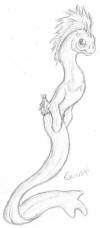
Fleerun
A large carnivorous animal, they will often hunt down kaasht and minena and eat them. They are known for their fleetness of foot and can over take a kaasht in a run. They are hard to kill, as their skin is like armor, and live in packs. They are about the size of a level 6 Forest Kaasht, and roam the whole of Tryne except for the water. Packs rarely exceed the number of twenty, although there have been reports of packs of fifty or more. Most often it is the strongest male and female that lead the pack. All members can breed though, and pups are often looked after scrupulously.
Froggen
This creature is omnivorous and solitary in nature and will eat just about anything. They are larger in size, about the size of a mid-aged Plains Kaasht, and live in the swamps and rivers and lakes of Tryne. They sometimes prey on kaasht, but that is only if they can catch them. They are slow and ponderous on land, but swift in the water. Some kaasht consider them a delicacy to eat, but most find their flesh revolting. They lay eggs once a year, and they tend to be sought after by kaasht for their unique flavor.

Gaari
These tiny brown insects are nothing but bloodsucking pests. Filling almost the same niche on Tryne that mosquitoes do on Earth, gaari will bite anything they can get their proboscises in. Being bloodsuckers, gaari have the potential to spread disease. Their bites are painless, since the insects are so small (1-2" long). Unlike mosquitoes, both male and female gaari bite. The females lay their eggs in rotting wood in the spring, so swarms of gaari are common in the summer.
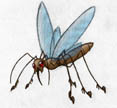
Gaileef
Considered the giraffe of the plains and forests, gaileef are huge herbivores. They tower above all kaasht, being about twice the size of an adult Desert kaasht. Gaileef are gentle herbivores, and are slow plodders, but are known for reaching high speeds if they feel the need to run. Kaasht rarely hunt this animal as it is difficult to pierce their thick skin. Baby gaileef are born live, and live with their mother for upwards of five years. Gaileef are solitary creatures, usually only coming together to mate.
Gotenk
Smaller herbivores, these creatures are almost exclusively domesticated for food. They are often kept in cities and in Clans as a source of easy food. They can live in a wide variety of places, and although there are a few wild varieties, most are domestic. They are about the size of a young Forest kaasht, and are sometimes kept for the rich milk they produce for their young.
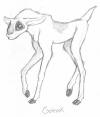
Grulper
Living almost exclusively in the mountains, grulpers will eat just about anything that comes their way. They have the innate ability to change their skin color to blend into their surroundings, and will often hunt Mountain kaasht. Grulpers mouths can open wide enough to fit half a Mountain kaasht's body into its mouth. They often grow to be twenty feet high and the tend to live either singularly or in pairs.

Gurgan
About twice the size of a Desert Kaasht, they are predators that will often go out of their way to kill kaasht. They have many sharp spines and horns, and have the unique ability to build a Shield around themselves. They are extremely hard to kill, and are dire enemies of all kaasht. They are surprisingly smart and ruthless. They tend to live alone, but a mated pair living together is not unheard of. Gurgan can live in just about every area of Tryne, except the tundra, water, and high mountains. They are most often seen though in the plains, deserts, and forest areas. Young gurgan leave their parents after five years of learning and join a group for a year or more, and are often known to terrorize kaasht and minena alike.

Hi'ner
Hi'ner are one of the many sea creatures that will actively hunt kaasht as a food source. There are many different varieties, being like the whales of our world. Some live in pods while others live singly or a female with a calf. They can grown as large as 200 feet, and are considered one of the biggest dangers of the sea. Young hi'ner are hunted by kaasht for their flesh, and are considered a delicacy. Adult hi'ner are also hunted, but not as actively.

H'kir
The H'kir is a large bird that cannot fly. They are about the size of an elephant, and are extremely fast runners. They use camouflage and their sharp talons for self defense. They live mainly on the plains and in the forest. The live in flocks, and reproduce quickly. They are often kept in herds for cities and Clans alike for food sources.
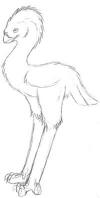
Imallin
These large fish are solitary predators that roam the ocean wherever smaller prey can be found. Imallin swim in deep waters and are very fierce, so some Beach kaasht enjoy taking the challenge of hunting down one of these 15-foot hunters. Their thick flesh makes excellent steaks, however, so most Beaches that take the challenge believe the reward well worth the effort.

Inaro
Inaren are large, predatory fish with fleshy fins and large jaws. Inaren will eat anything they can fit inside their gaping mouths, and will greedily consume carrion. Growing up to 10 feet long, even unwary Beach kits can fall prey to this unprejudiced hunter. An inaro's poisonous flesh makes it unsuitable for eating.
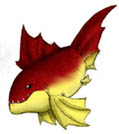
Jaanik
A swift herbivore, jaanik are most often found in the plains. Jaanik live in groups of up to ten, each with sensitive hearing and an excellent sense of smell. These creatures are often hunted, and some Clans have domesticated a few for consumption. Young females are often allowed to stay in the herd the were born in, but males are forced out to live on their own.

Kaashtu
Ranging in size from dog to moose, they mainly live in the Mountains, Valleys, and Caves. Each is suited to where it lives. Their defense is the ability to hide their heat (in the Caves) and has the ability to turn itself into a rock to get away from predators. They can also have a tendency, when a mother is guarding young, to attack kaasht. They live in a mother/young group, with the father having nothing to do with the group, and once the young are grown, strike off on their own.

Keskin
A lizard like creature, they live in small packs. They are creatures of the valleys and forests, blending in well with their ability to change their skin texture and color. They are agile and fast, and grow to be about the size of a horse. Sometimes they are hunted by kaasht, but they are often found to be bad tasting and not worth the trouble of finding. They grow to the size of a horse, and will sometimes hunt down young kits and minena.

Kree
A two legged creature that roams all of Tryne. They are about the size of an adult Old Mystic and live in large packs. They have sharp eyes and a sharp sense of smell. The whole pack has a sort of psychic link with each other so that a warning can be passed within a blink of an eye. Both males and females live in the herd, and young are cared for by the whole herd. They are often hunted by kaasht, and many times are kept in herds for both Clans and cities as an easy food source.
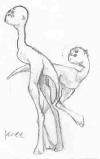
Krithka
Distant relatives of the large, predatory fleerun, krithka are Tryne's equivalent to vultures. They can be found anywhere there are thermals to keep them aloft - usually the plains and deserts - as the frail creatures are relatively helpless on the ground. Krithka land only to sleep, eat, mate, and give birth to their live young. Male and female krithka come together only for the mating season, otherwise traveling in groups of 2 to 5 bachelors or bachelorettes (called such regardless of whether the krithka has ever mated). Krithka flocks often follow desert gurgans, as the huge predators often leaves scraps behind after a kill, and never attack the 5-foot-tall scavengers.
